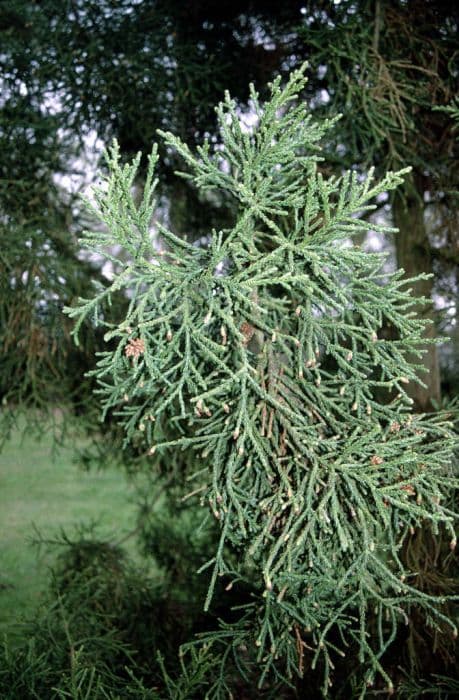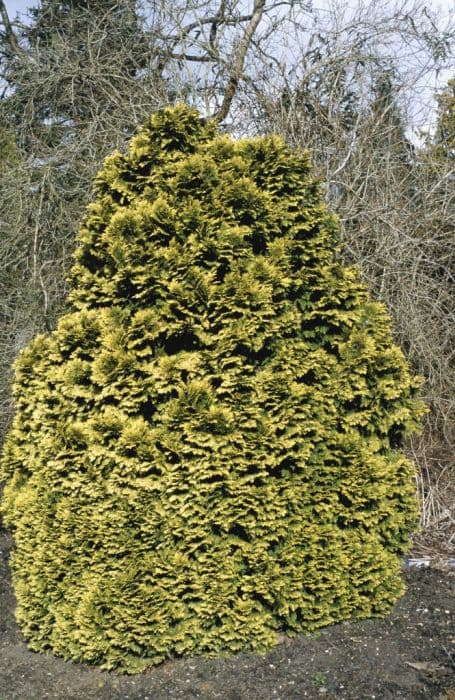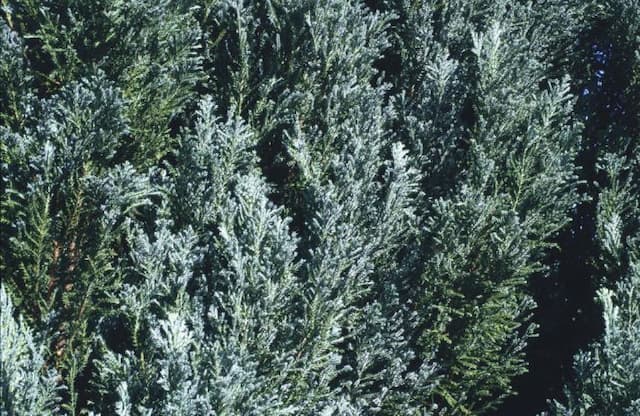White Cedar Chamaecyparis thyoides 'Ericoides'

ABOUT
Chamaecyparis thyoides 'Ericoides', commonly known as the Atlantic White Cedar, is known for its unique and attractive appearance. The foliage of this plant is characterized by its fine, feathery texture that closely resembles the needles of a conifer. The leaves typically display a bright green color during the growing season and can have a slightly bluish or grayish tint, adding to its visual appeal. The overall growth habit of the Atlantic White Cedar 'Ericoides' is dense and compact, lending itself to a rounded or conical shape. This makes it a popular choice for hedges, screens, and as a focal point in a landscaping design. The small scale-like leaves hug the branches, which are numerous and closely arranged, giving the plant a full and lush look. In addition to the appealing foliage, the Atlantic White Cedar 'Ericoides' may produce small, inconspicuous cones that can add a subtle textural element to the plant. These cones are often not a prominent feature but serve as an added interest for close-up viewing. The bark of the plant is typically reddish-brown and can develop a fibrous texture over time, providing another layer of visual interest and contrast against the softer textures of the foliage.
About this plant
 Names
NamesFamily
Cupressaceae.
Synonyms
Atlantic White Cedar, Dwarf Coastal White Cedar, Henkel's Dwarf Hinoki.
Common names
Chamaecyparis thyoides 'Ericoides'.
 Toxicity
ToxicityTo humans
The Chamaecyparis thyoides 'Ericoides', commonly known as White Cedar, is generally not considered highly toxic to humans. However, as with many plants, if ingested in large quantities it may cause some discomfort or gastrointestinal upset. There are no well-documented cases of serious poisoning or severe symptoms directly attributed to the ingestion of White Cedar.
To pets
White Cedar is not typically known for being highly toxic to pets. If a pet ingests a small amount of this plant, they may experience mild gastrointestinal upset, including vomiting or diarrhea. However, it is not known to cause severe poisoning or life-threatening symptoms in pets. As with any non-food plant, it is wise to prevent pets from ingesting significant quantities to avoid potential digestive issues.
 Characteristics
CharacteristicsLife cycle
Perennials
Foliage type
Evergreen
Color of leaves
Green
Height
2-3 feet (0.6-0.9 meters)
Spread
1-2 feet (0.3-0.6 meters)
Plant type
Shrub
Hardiness zones
4-8
Native area
North America
Benefits
 General Benefits
General Benefits- Ornamental Value: Chamaecyparis thyoides 'Ericoides', commonly known as White Cedar, has a unique visual appeal due to its compact size and fine, feathery foliage.
- Landscape Design Flexibility: Its small stature and slow growth make it suitable for a variety of landscaping uses including foundation plantings, rock gardens, and as a specimen plant.
- Drought Tolerance: Once established, White Cedar exhibits a measure of drought resistance, making it suitable for drier climates or water-conserving gardens.
- Wildlife Habitat: Provides cover and nesting opportunities for birds and other small wildlife.
- Minimal Maintenance: Requires little pruning or other maintenance, making it ideal for low-maintenance landscapes.
- Winter Interest: Retains its foliage year-round, adding greenery and textural interest to winter landscapes.
 Medical Properties
Medical PropertiesThis plant is not used for medical purposes.
 Air-purifying Qualities
Air-purifying QualitiesThis plant is not specifically known for air purifying qualities.
 Other Uses
Other Uses- Topiary Art: The Atlantic white cedar 'Ericoides' can be sculpted into various shapes for garden art or topiary designs due to its fine texture and dense foliage.
- Insect Repellent: The aromatic wood and leaves can be used to repel insects like moths from closets and drawers.
- Model Making: The fine grain wood of the Atlantic white cedar is valued for creating detailed models and intricate woodworking projects.
- Privacy Screens: This plant is often used in landscaping to create natural and aesthetically pleasing privacy screens.
- Soil Stabilization: The plant’s root system is effective for erosion control and soil stabilization in wetland areas.
- Habitat Creation: When planted in groups, the Atlantic white cedar creates habitats that are beneficial for birds and small wildlife.
- Wood Carving: Craftsmen use the wood of Atlantic white cedar for carving decorative objects due to its ease of working and finishing.
- Acoustic Insulation: The dense growth habit is useful in landscapes requiring noise reduction or acoustic insulation.
- Bonsai: The 'Ericoides' variety can be trained as a bonsai, providing an appealing miniature landscape element for enthusiasts.
- Theme Gardens: This plant can be used to create themed garden areas, such as a ‘native plants’ or ‘evergreen’ garden.
Interesting Facts
 Feng Shui
Feng ShuiThe Atlantic White Cedar is not used in Feng Shui practice.
 Zodiac Sign Compitability
Zodiac Sign CompitabilityThe Atlantic White Cedar is not used in astrology practice.
 Plant Symbolism
Plant Symbolism- Longevity: Chamaecyparis thyoides 'Ericoides', commonly known as the Atlantic White Cedar, is a coniferous tree that can live for hundreds of years, symbolizing endurance, stamina, and the passage of time.
- Protection: Like many evergreens, the Atlantic White Cedar is often associated with protection and shelter, since its dense foliage provides cover for wildlife and its wood was historically used for building durable structures.
- Purity: The cedar tree has been a symbol of purity due to its clean fragrance and the natural oils that resist rot, symbolizing cleanliness, health, and resilience against corruption or decay.
- Sanctity: In various cultures, cedar wood is considered sacred and is used in religious rituals and ceremonies, representing holiness, divinity, and spiritual elevation.
 Water
WaterThe Atlantic White Cedar, scientifically named Chamaecyparis thyoides 'Ericoides', should be watered deeply to ensure the soil is moist but not saturated. During the growing season, watering approximately once a week with 1 to 1.5 gallons of water is typically adequate, but always check the soil moisture before watering as conditions can vary greatly. In extremely hot or dry weather, you may need to water more frequently. Reduce watering in the winter when plant growth slows down. Over-watering can be as harmful as under-watering, so it is crucial to ensure proper drainage and avoid letting the plant sit in water.
 Light
LightThe Atlantic White Cedar thrives in full sun to partial shade conditions. It is best to place the plant in a location where it will receive at least four to six hours of direct sunlight daily, but it can also tolerate and adapt to light shade. Avoid deep shade locations as insufficient sunlight can lead to sparse foliage and poor growth.
 Temperature
TemperatureThe Atlantic White Cedar is well-adapted to a wide range of temperatures but prefers a cooler climate. It can generally tolerate temperatures as low as -30°F and as high as 100°F, but the ideal temperature range is between 40°F to 70°F for optimal growth.
 Pruning
PruningPruning of the Atlantic White Cedar is not strictly necessary but can be done for shaping purposes. If desired, prune in late winter or early spring before new growth starts. This helps to maintain a desired shape and size and can also prevent the spread of any diseases. Pruning every year or every other year is generally sufficient.
 Cleaning
CleaningAs needed
 Soil
SoilThe Atlantic White Cedar 'Ericoides' performs best in evenly moist, acidic soil with a pH range of 4.5 to 5.5. A soil mix should be well-draining and can be amended with peat moss and sand to maintain moisture while providing good aeration. Mulching is beneficial to retain soil moisture.
 Repotting
RepottingAtlantic White Cedar 'Ericoides' should be repotted every two to three years to refresh the soil, though mature plants can be repotted less frequently. The best time to repot is in the early spring before new growth begins.
 Humidity & Misting
Humidity & MistingAtlantic White Cedar 'Ericoides' thrives in moderate to high humidity conditions. Maintaining humidity levels of 50-70% is ideal for optimal growth, though it can tolerate lower humidity unlike many other conifers.
 Suitable locations
Suitable locationsIndoor
Provide bright indirect light and consistent moisture indoors.
Outdoor
Needs full sun to partial shade, regular watering.
Hardiness zone
4-8 USDA
 Life cycle
Life cycleThe Atlantic White Cedar 'Ericoides' (Chamaecyparis thyoides 'Ericoides') begins its life as a seed, often requiring moist, acidic soil conditions to germinate. Once sprouted, the seedling grows through a juvenile stage characterized by rapid vertical growth and the formation of scale-like, bluish-green leaves in dense, fine sprays. As it matures into a sapling, the plant's growth rate may slow, but it continues to develop a conical shape with a somewhat irregular outline. Reaching maturity, the Atlantic White Cedar 'Ericoides' can develop into a small to medium-sized tree with dense, soft, fine-textured foliage that often takes on a gray-green to blue-green hue in the landscape. During the reproductive stage, small, inconspicuous cones are produced, which then release seeds to propagate the next generation. In its final stage, the plant's growth slows significantly and it may be subject to various environmental stresses or diseases, leading potentially to its decline and eventual death.
 Propogation
PropogationPropogation time
Late winter-early spring
Propogation: Chamaecyparis thyoides 'Ericoides', commonly known as Atlantic White Cedar, is typically propagated by semi-hardwood cuttings. The best time for taking cuttings is in the late summer to early fall when the new growth has started to mature but is not yet fully hardened. Cuttings should be about 4 to 6 inches (approximately 10 to 15 centimeters) long, and the lower needles should be removed to expose a bare stem that can be inserted into a rooting medium. This medium is often a mixture of peat and perlite to provide aeration and moisture retention. The cuttings should be kept under high humidity, which can be achieved by using a misting system or placing plastic covers over the propagation area. Rooting hormone is typically used to encourage root development, applied to the cut stem before planting. Once the cuttings develop a robust root system, they can be potted individually and eventually planted out.









